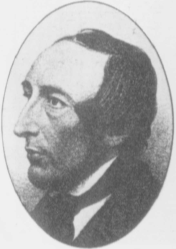Related Research Articles

Thomas Carlyle was a Scottish essayist, historian, and philosopher from the Scottish Lowlands. A leading writer of the Victorian era, he exerted a profound influence on 19th-century art, literature, and philosophy.

John Mitchel was an Irish nationalist writer and journalist chiefly renowned for his indictment of British policy in Ireland during the years of the Great Famine. Concluding that, in Ireland, legal and constitutional agitation was a "delusion", Mitchel broke first with Daniel O'Connell's Repeal Association and then with his Young Ireland colleagues at the paper The Nation. In 1848, as editor of his own journal, United Irishman, he was convicted of seditious libel and sentenced to 14-years penal transportation for advocating James Fintan Lalor's programme of co-ordinated resistance to landlords and to the continued shipment of harvests to England.

The Nation was an Irish nationalist weekly newspaper, published in the 19th century. The Nation was printed first at 12 Trinity Street, Dublin from 15 October 1842 until 6 January 1844. The paper was afterwards published at 4 D'Olier Street from 13 July 1844, to 28 July 1848, when the issue for the following day was seized and the paper suppressed. It was published again in Middle Abbey Street on its revival in September 1849 until 1900, when it merged with the Irish Weekly Independent.

Thomas Osborne Davis was an Irish writer; with Charles Gavan Duffy and John Blake Dillon, a founding editor of The Nation, the weekly organ of what came to be known as the Young Ireland movement. While embracing the common cause of a representative, national government for Ireland, Davis took issue with the nationalist leader Daniel O'Connell by arguing for the common ("mixed") education of Catholics and Protestants and by advocating for Irish as the national language.

Sir Charles Gavan Duffy, KCMG, PC, was an Irish poet and journalist, Young Irelander and tenant-rights activist. After emigrating to Australia in 1856 he entered the politics of Victoria on a platform of land reform, and in 1871–1872 served as the colony's 8th Premier.

John Blake Dillon was an Irish writer and politician who was one of the founding members of the Young Ireland movement.

Young Ireland was a political and cultural movement in the 1840s committed to an all-Ireland struggle for independence and democratic reform. Grouped around the Dublin weekly The Nation, it took issue with the compromises and clericalism of the larger national movement, Daniel O'Connell's Repeal Association, from which it seceded in 1847. Despairing, in the face of the Great Famine, of any other course, in 1848 Young Irelanders attempted an insurrection. Following the arrest and the exile of most of their leading figures, the movement split between those who carried the commitment to "physical force" forward into the Irish Republican Brotherhood, and those who sought to build a "League of North and South" linking an independent Irish parliamentary party to tenant agitation for land reform.
Patrick Aloysius Murray DD STP (1811–1882) was an Irish Roman Catholic theologian.

Dr. Robert Cane (1807–1858), was born in Kilkenny, Ireland in 1807. He was a member of the Repeal Association and the Irish Confederation. He qualified as an M.D. in 1836, became a member of Kilkenny Corporation and was Mayor twice.

John O'Leary was an Irish separatist and a leading Fenian. He studied both law and medicine but did not take a degree and for his involvement in the Irish Republican Brotherhood, he was imprisoned in England during the nineteenth century.
John Edward Pigot (1822–1871) was an Irish music collector and lawyer, who played a key role in the foundation of the National Gallery of Ireland.
John Kells Ingram was an Irish mathematician, economist and poet who started his career as a mathematician. He has been co-credited, along with John William Stubbs, with introducing the geometric concept of inversion in a circle.
George Otto Simms was an archbishop in the Church of Ireland, and a scholar.

Patrick O'Donoghue (1810–1854), also known as Patrick O'Donohoe or O'Donoghoe, from Clonegal, County Carlow, was an Irish Nationalist revolutionary and journalist, a member of the Young Ireland movement.

John Martin was an Irish nationalist activist who shifted from early militant support for Young Ireland and Repeal, to non-violent alternatives such as support for tenant farmers' rights and eventually as the first Home Rule MP, for Meath 1871–1875.
The Irish Confederation was an Irish nationalist independence movement, established on 13 January 1847 by members of the Young Ireland movement who had seceded from Daniel O'Connell's Repeal Association. Historian T. W. Moody described it as "the official organisation of Young Ireland".

Thomas Devin Reilly(Tomás Damhán Ó Raghailligh) was an Irish revolutionary, Young Irelander and journalist.

Charles O'Conor, RIA, also known as Charles O'Conor of Belanagare, was a member of the Gaelic nobility of Ireland and antiquarian who was enormously influential as a protagonist for the preservation of Irish culture and Irish mythology during the 18th century. He combined an encyclopaedic knowledge of Irish manuscripts and Gaelic culture in demolishing many specious theories and suppositions concerning Irish history.
Thomas MacNevin was an influential Irish writer and journalist, who died under "peculiarly sad circumstances" in a Bristol asylum.
John William Stubbs was an Irish mathematician and clergyman who served as bursar of Trinity College Dublin (TCD). He has been co-credited with introducing the geometric concept of inversion in a circle, and late in life he authored a book on the history of the University of Dublin.
References
- ↑ John Kells Ingram - Sonnets and Other Poems - Adam & Charles Black, London 1900, page 9
- Attribution
 This article incorporates text from a publication now in the public domain : Herbermann, Charles, ed. (1913). "John O'Hagan". Catholic Encyclopedia . New York: Robert Appleton Company. The entry cites:
This article incorporates text from a publication now in the public domain : Herbermann, Charles, ed. (1913). "John O'Hagan". Catholic Encyclopedia . New York: Robert Appleton Company. The entry cites: - The Irish Monthly, XVIII;
- Duffy, Four Years of Irish History